Ijraset Journal For Research in Applied Science and Engineering Technology
- Home / Ijraset
- On This Page
- Abstract
- Introduction
- Conclusion
- References
- Copyright
Exploring the Potential of Edge Computing: Use Cases and Benefits
Authors: Vishwanath V K, Dr. Gururaj T
DOI Link: https://doi.org/10.22214/ijraset.2023.56294
Certificate: View Certificate
Abstract
As cloud services and the Internet of Things continue to grow, a new computing paradigm has emerged - Edge Computing. This paper aims to explore the potential of Edge Computing by highlighting distinct use cases and benefits. By processing data at the network\'s edge, Edge Computing can address issues such as reaction speed, battery life, and data security. This paper also discusses the difference between cloud computing and Edge Computing, and presents a case study to demonstrate the practical applications of Edge Computing. The findings of this paper suggest that Edge Computing has the potential to revolutionize various industries and improve access quality for users.
Introduction
I. INTRODUCTION
The introduction of cloud computing in 2005 has transformed the way we live, work, and study. With the rise of cloud services and the Internet of Things, a new computing paradigm has emerged - Edge Computing. Edge Computing is a distributed computing model that processes data at the network's edge, closer to the source of data generation. This paper aims to explore the potential of Edge Computing by highlighting its benefits and use cases in various industries. By processing data at the edge, Edge Computing can address issues such as reaction speed, battery life, and data security. This paper also discusses the difference between cloud computing and Edge Computing, and presents a case study to demonstrate the practical applications of Edge Computing. The findings of this paper suggest that Edge Computing has the potential to revolutionize various industries and improve access quality for users.
A. The origin of Edge Computing
Edge computing has its roots in the 1990s when content delivery networks (CDNs) were developed to transmit video and online content using edge servers located closer to customers. These networks evolved in the 2000s, and began hosting apps and app components directly on edge servers. This was the first commercial application of edge computing. Edge computing solutions and services were eventually built to host apps like shopping carts, real-time data gathering, ad insertion, and more. Today, edge computing has become an essential technology for processing data at the network's edge, closer to the source of data generation.
B. Defining Edge Computing
Edge computing is a distributed computing architecture that involves moving data storage and computation closer to the data source. This reduces bandwidth usage and improves response time by reducing the number of cloud-based tasks. Computing tasks are moved to edge devices such as IoT devices, edge servers, or users' laptops, which reduces long-distance transmission between a server and a client. As a result, bandwidth use and latency are reduced. Edge computing has become increasingly important for enterprises as it can boost productivity, cut costs, and even generate new revenue streams. The limitations of centralized computing have become more apparent in recent years, especially during the COVID-19 era, as remote workforces expand. By processing data at the network's edge, Edge Computing can help achieve the Doherty barrier of less than 400 millisecond replies, which can significantly improve productivity.
C. Importance of Edge Computing
Edge computing is becoming increasingly important as it allows for novel customer experiences for interaction-intensive businesses like retail and banking. All industries can benefit from bringing infrastructure and workloads closer to where data is generated and consumed. Edge computing combined with IoT and AI can increase the uptime of key equipment in asset-intensive industries like manufacturing and transportation. Content delivery networks and media, video gaming, smart manufacturing, logistics and warehousing, utilities, and transportation are all common application cases.
Industries where low-latency, data-intensive activities are in great demand, such as telemedicine, financial technology, and public safety, are witnessing rapid adoption of edge computing. By processing data at the network's edge, Edge Computing can help achieve the Doherty barrier of less than 400 millisecond replies, which can significantly improve productivity. Enterprises can increasingly deploy cloud technology for proximity computing use cases, which can boost productivity, cut costs, and even generate new revenue streams.
D. Significance of Edge Computing
Edge computing is significant because it can reduce latency between an end user and the application they're accessing by moving computing, storage, and/or network resources to the network border. This reduces the physical distance between a user and the resources they are attempting to access.
Furthermore, network latency can degrade the speed and efficacy of real-time applications, sending huge amounts of data can be costly, and some industry and government rules now specify where data must be stored. Edge computing is allowing novel customer experiences for interaction-intensive businesses like retail and banking. All industries can benefit from bringing infrastructure and workloads closer to where data is generated and consumed.
Edge computing combined with IoT and AI can increase the uptime of key equipment in asset-intensive industries like manufacturing and transportation.
Content delivery networks and media, video gaming, smart manufacturing, logistics and warehousing, utilities, and transportation are all common application cases. Industries where low-latency, data-intensive activities are in great demand, such as telemedicine, financial technology, and public safety, are witnessing rapid adoption of edge computing.
II. RELATED WORK
A. Review of IoT and Edge Computing
- IoT: The traditional computing based on a stationary desktop will be obsolete in the future. The Internet of Things (IoT) is fast integrating into daily life, and it anticipates most physical items being connected to data centers, exchanging information, and ushering in the next huge leap in data production scale. IoT will have a significant impact on prospective consumers' daily lives and is the key to the future. The Internet of Things (IoT) is also essential in the field of business and has been identified as one of the most essential technologies that will have an impact on US interests by 2025.
- Edge Computing: Edge Computing is a new computing paradigm that has emerged due to the popularity of rich cloud services and the growth of the Internet of Things. It involves processing data at the network's edge, closer to where data is generated and consumed, rather than in a centralized data center. This reduces latency between an end user and the application they're accessing, which can significantly improve productivity. Edge Computing is becoming increasingly important as it allows for novel customer experiences for interaction-intensive businesses like retail and banking. All industries can benefit from bringing infrastructure and workloads closer to where data is generated and consumed. Edge computing combined with IoT and AI can increase the uptime of key equipment in asset-intensive industries like manufacturing and transportation. Content delivery networks and media, video gaming, smart manufacturing, logistics and warehousing, utilities, and transportation are all common application cases. Industries where low-latency, data-intensive activities are in great demand, such as telemedicine, financial technology, and public safety, are witnessing rapid adoption of edge computing.
III. CASE STUDY
A. Smart Grid
Smart Grids, which are modern power grids that generate massive amounts of data every second. To translate this data into useful information and knowledge that can be used for Smart Grid operations and services, advanced data analytic methods are necessary. These data analytics rely on information and communication technologies (ICTs), which play a crucial role in data gathering, transmission, and processing.
Smart Grids are an essential component of the modern power grid and are becoming increasingly important as we move towards a more sustainable future.
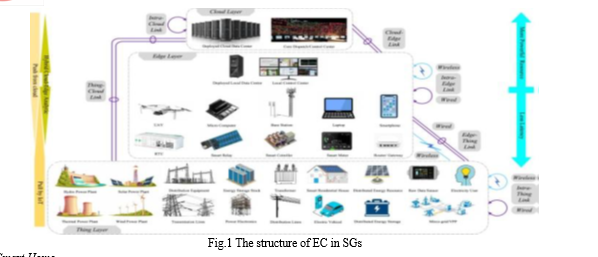
B. Smart Home
Smart Homes, are homes equipped with smart devices that can be connected to the internet. Smart homes have become an essential component of the Internet of Things (IoT) due to the rapid development and use of smart devices. Smart devices such as smart TVs, smart lights, and robot vacuums have been invented to make our lives more convenient and pleasant. However, experts are concerned about the security of smart homes due to the widespread use of smart gadgets. Smart homes are vulnerable to various types of assaults that could compromise users' privacy. Therefore, minimizing the amount of data transported to the cloud can aid in improving the privacy and security of users.
C. Smart Agriculture
Smart Agriculture, which involves using a variety of Information and Communication Technologies (ICTs) to increase productivity in a sustainable and profitable way. Smart Agriculture is technology-agnostic and envisions the provision of a set of technologies that can be used as needed depending on the situation. These technologies can be used at any point along the agricultural value chain, from the farmer to the consumer. The adoption of ICTs in the agriculture industry is challenging, but it is expected to expand. Smart Agriculture has well-documented advantages such as cost-effectiveness and sustainability. The market for smart agriculture goods is expected to grow significantly in the coming years.
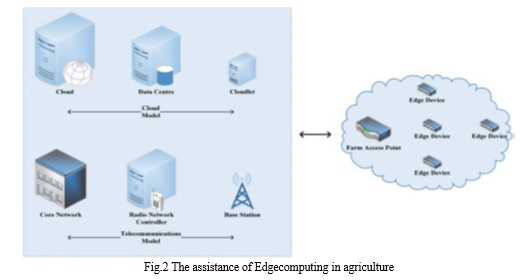
D. Cloud Computing
Cloud Computing, which is a computing paradigm that involves connecting geographically dispersed devices and equipment to cloud data centers. Cloud computing is a centralized approach that makes centralized judgments and issues control commands. However, it has some limitations, including limited bandwidth resources, heterogeneous contexts, and privacy issues. Cloud computing is insufficient to accommodate some IoT applications that require a quick reaction time, include sensitive data, or generate a large amount of data, putting a strain on networks.
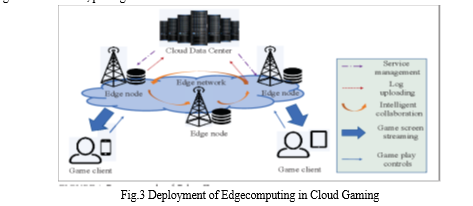
E. Content Delivery Networks
Content Delivery Networks (CDNs), which are large distributed systems of cache servers that allow Internet content to be replicated across several locations. The fundamental goal of CDNs is to bring material closer to end-users to increase delivery system speed and reduce media application network footprint. CDNs fetch material from the closest known cache server, dramatically lowering content delivery latency and improving the user experience of using the service. CDNs can replicate a variety of dynamic and static material, such as streaming audio/video and software releases, using various strategies such as DNS-based redirection, URL rewriting, and HTTP redirection. CDNs are frequently used by businesses that offer material via networks because of their versatility and support for numerous types of information. Effective CDN service placement is a critical issue with implications for a wide range of large-scale systems, as CDN traffic today accounts for a sizable amount of Internet traffic.
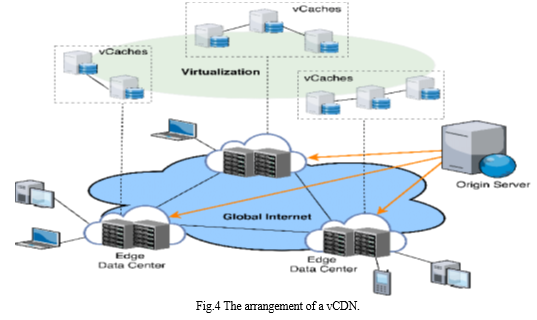
F. Smart health
Smart Health, which is a context-aware evolution of mobile health that uses wireless communication technology to empower healthcare stakeholders with innovative tools and solutions that potentially transform service delivery. Smart Health systems make use of a variety of wireless sensors, cameras, and controllers that allow for automatic patient identification and tracking, correct drug-patient associations, and rigorous real-time vital sign monitoring to detect clinical deterioration early. All of this generates a large volume of data that must be transmitted, processed quickly, and stored while maintaining privacy. Given these criteria, the traditional cloud computing paradigm becomes unsuitable for Smart Health, as a centralized method will not be able to deliver a sufficient level of scalability and responsiveness, and will impose an extremely high traffic burden on communication networks. As a result, a new approach known as Multi-access Edge Computing (MEC) has arisen, which is described as the ability to process and store data at the network's edge, i.e., close to the data sources. The benefits of MEC in a Smart Health setting are numerous, including faster response times, lower energy usage for battery-operated devices, reduced network bandwidth use, secure transmission, and data privacy.

G. Edge Computing in oil Field
Oil Field, which is the implementation of digital technology in field operations, often known as "on-the-edge" computing. The oil and gas sector has benefited substantially from new digital capabilities in recent years, which have resulted in numerous step improvements in performance across the E&P value chain. Edge Computing and Industrial Internet of Things (IIoT) technology have just emerged, and they have had a favorable impact on manufacturing operations. These new technologies are paving the way for the oilfield's next wave of digital revolution. Powerful Edge Computing enables data contextualization at the point of generation, resulting in meaningful actionable insights being delivered on-site. As a result, the cost of data transmission and storage is greatly lowered. Furthermore, the raw data and/or actionable insights can be sent back to big data environments like the cloud or used for automation at the edge, resulting in a distributed intelligent environment, or the Internet of Intelligent Things. Edge applications—performance-enhancing domain-specific workflows and algorithms based on machine learning or artificial intelligence—are used to achieve automation and/or control. To enable fully autonomous operations, these applications can also be used in a variety of network settings, including as cellular, WiFi, and fixed access technologies.
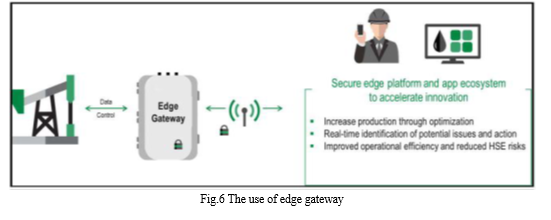
H. Edge Computing for Autonomous Driving
The purpose of Autonomous Driving Edge Computing Systems is to ensure that autonomous vehicles are safe. This is exceedingly difficult since autonomous vehicles must handle massive amounts of data in real-time while adhering to extremely tight latency limits. For example, if an autonomous vehicle goes at 60 miles per hour (mph) and has a braking distance of around 30 meters, the autonomous driving system must detect probable threats up to a few seconds ahead of time. As a result, the safer the autonomous car is, the faster the Autonomous Driving Edge Computing System conducts these sophisticated computations. The Autonomous Driving Edge Computing System's overarching challenge is to efficiently integrate the functional modules, including interactions with edge servers and V2X infrastructure, to process a massive amount of heterogeneous data in real-time while staying within a limited energy budget and without jeopardizing user security. To achieve this, state-of-the-art approaches in these domains, as well as prospective solutions to these problems, are examined in this research. The Edge Computing architecture for Autonomous Driving is shown in Figure 7, which demonstrates how the functional modules interact with edge servers and V2X infrastructure to process a massive amount of heterogeneous data in real-time.

Conclusion
It is clear that Edge Computing is a rapidly growing technology that has the potential to revolutionize the way we process and analyze data. By bringing computing power closer to the source of data, Edge Computing can significantly reduce latency, improve data security, and enable real-time decision-making. From Smart Health to Autonomous Driving and Oil Field operations, Edge Computing is being implemented in a variety of industries to improve efficiency, reduce costs, and enhance safety. As the technology continues to evolve, we can expect to see even more innovative use cases emerge. Overall, Edge Computing is a promising technology that has the potential to transform the way we live and work.
References
[1] M. Armbrust, A. Fox, R. Griffith, A. D. Joseph, R. Katz, A. Konwinski, G. Lee, D. Patterson, A. Rabkin, I. Stoica et al., “A view of cloud computing,” Communications of the ACM, vol. 53, no. 4, pp. 50–58,2010. [2] S. Ghemawat, H. Gobioff, and S.-T. Leung, “The google file system,” in ACM SIGOPS operating systems review, vol. 37, no. 5. ACM, 2003,pp. 29–43. [3] J. Dean and S. Ghemawat, “Mapreduce: simplified data processing on large clusters,”Communications of the ACM, vol. 51, no. 1, pp. 107–113,2008. [4] K. Shvachko, H. Kuang, S. Radia, and R. Chansler, “The hadoop distributed file system,” in Mass Storage Systems and Technologies (MSST), 2010 IEEE 26th Symposium on. IEEE, 2010, pp. 1–10. [5] M. Zaharia, M. Chowdhury, M. J. Franklin, S. Shenker, and I. Stoica, “Spark: cluster computing with working sets,” in Proceedings of the 2nd USENIX conference on Hot topics in cloud computing, vol. 10, 2010, p. 10. [6] K. Ashton, “That internet of things thing,” RFiD Journal, vol. 22, no. 7,pp. 97–114, 2009. [7] H. Sundmaeker, P. Guillemin, P. Friess, and S. Woelffl´e, “Vision and challenges for realising the internet of things,” 2010. [8] J. Gubbi, R. Buyya, S. Marusic, and M. Palaniswami, “Internet of things (iot): A vision,architectural elements, and future directions,” Future Generation Computer Systems, vol. 29, no. 7, pp. 1645–1660, 2013. [9] “Cisco global cloud index: Forecast and methodology, 2014-2019 white paper,” 2014. [10] “IDC futurescape: Worldwide internet of things 2016 predictions,” 2015. [11] D. Evans, “The internet of things: How the next evolution of the internet is changing everything,” CISCO white paper, vol. 1, p. 14, 2011. [12] J. Gubbi, R. Buyya, S. Marusic, and M. Palaniswami, ‘‘Internet of Things (IoT): A vision, architectural elements, and future directions,’’ Future Generat. Comput. Syst., vol. 29, no. 7, pp. 1645–1660, 2013. [13] The national intelligence council sponsor workshop. (2008). Intelligence, S. C. B., 2008. Disruptive Civil Technologies. Six Technologies With Potential Impacts on US Interests out to 2025. [Online]. Available: https://fas.org/irp/nic/disruptive.pdf [14] K. Rose,S.Eldridge, and L. Chapin, ‘‘The Internet of Things: An overview,’’ in Proc.Internet Soc. (ISOC), 2015, pp. 1–53 [15] W. Yu, H. Xu, H. Zhang, D. Griffith, and N. Golmie, ‘‘Ultra-dense networks: Survey of state of the art and future directions,’’ in Proc. 25th Int. Conf. Comput. Commun. Netw.(ICCCN), Aug. 2016, pp. 1–10. [16] M. Agiwal, A. Roy, and N. Saxena, ‘‘Next generation 5G wireless networks: A comprehensive survey,’’ IEEE Commun. Surveys Tuts., vol. 18, no. 3, pp. 1617–1655,3rd Quart., 2016. [17] P. Demestichas et al., ‘‘5G on the horizon: Key challenges for the radioaccess network,’’ IEEE Veh. Technol. Mag., vol. 8, no. 3, pp. 47–53, Sep. 2013. [18] A. Ahmed and E.Ahmed, ‘‘A survey on mobile edge computing,’’ in Proc. 10th Int.Conf. Intell. Syst.Control (ISCO), Jan. 2016, pp. 1–8. [19] Fang X, Misra S, Xue G, Yang D. Smart grid the new and improved power grid: a survey. IEEE Commun Surv Tutor 2012;14(4):944–80. doi:10.1109/SURV.2011.101911.00087 . [20] Bera S , Misra S , Rodrigues JJPC . Cloud computing applications for smart grid: a survey. IEEE Trans Parallel Distrib Syst 2015;26(5):1477–94 . [21] Shi W , Cao J , Zhang Q , Li Y , Xu L . Edge computing: vision and challenges. IEEE Internet Things J 2016;3(5):637–46 . [22] L. Atzori, A. Iera, and G. Morabito, “The internet of things: A survey,” Computer networks, vol. 54, no. 15, pp. 2787–2805, 2010. [23] B. L. R. Stojkoska and K. V. Trivodaliev, “A review of internet of things for smart home Challenges and solutions,” Journal of Cleaner Production, vol. 140, pp. 1454–1464, 2017. [24] J. Lwowski, P. Kolar, P. Benavidez, P. Rad, J. J. Prevost, and M. Jamshidi, “Pedestrian detection system for smart communities using deep convolutional neural networks,” in 2017 12th System of Systems Engineering Conference (SoSE). IEEE, 2017, pp. 1–6. [25] G. Muhammad, M. F. Alhamid, M. Alsulaiman, and B. Gupta, “Edge computing with cloud for voice disorder assessment and treatment,” IEEE Communications Magazine, vol. 56, no. 4, pp. 60–65, 2018. [26] C. Lee, L. Zappaterra, K. Choi, and H.-A. Choi, “Securing smart home: Technologies, security challenges, and security requirements,” in 2014 IEEE Conference on Communications and Network Security. IEEE, 2014, pp. 67–72. [26] J. Zhou, T. Leppanen, E. Harjula, M. Ylianttila, T. Ojala, C. Yu, H. Jin,and L. T. Yang, “Cloudthings: A common architecture for integrating the internet of things with cloud computing,” in Proceedings of the 2013 IEEE 17th international conference on computer supported cooperative work in design (CSCWD). IEEE, 2013, pp. 651–657. [27] A. Barbir, B. Cain, R. Nair, and O. Spatscheck, “Known content network (CN) request-routing mechanisms,” July 2003. RFC 3568. [28] J. Sahoo, M. A. Salahuddin, R. Glitho, H. Elbiaze, and W. Ajib, “A survey on replica server placement algorithms for content delivery networks,” IEEE Communications Surveys Tutorials, vol. 19, pp. 1002–1026, Secondquarter 2017. [29] E. Nygren, R. K. Sitaraman, and J. Sun, “The Akamai network: A platform for high-performance Internet applications, ” SIGOPS Operating Systems Review, vol. 44, pp. 2–19, Aug. 2010. [30] A. A. Abdellatif, M. G. Khafagy, A. Mohamed, and C. Chiasserini,“EEG-based transceiver design with data decomposition for healthcare IoT applications,” IEEE Internet of Things Journal, vol. 5,no. 5, pp. 3569–3579, 2018. [31] S. Liu, J. Tang, Z. Zhang, and J.-L. Gaudiot,“Computer architectures for autonomous driving,” Computer, vol. 50, no. 8, pp. 18–25, 2017. [32] S. Liu, J. Peng, and J.-L. Gaudiot, “Computer, drive my car!” Computer, vol. 50, no. 1, p.8, 2017. [33] S. Neelambike, J. Chandrika, \"An efficient environmental model considering environmental factor for V2I application services,\" 2015 IEEE International Conference on Computational Intelligence and Computing Research (ICCIC), 2015, pp. 1-6, doi: 10.1109/ICCIC.2015.7435731. [34] Vishwas, D. B., M. Gowtham, H. L. Gururaj, and Sam Goundar. \"Industrial Internet of Things 4.0: Foundations, Challenges, and Applications–A Review.\" In Innovations in the Industrial Internet of Things (IIoT) and Smart Factory, pp. 172-191. IGI Global, 2021. [35] Thimmaiah, C. D., S. Disha, Deeksha Nayak, B. B. Diya, and H. L. Gururaj. \"Decentralized electronic medical records.\" International Journal of Research and Analytical Reviews 6, no. 1 (2019): 199-203.
Copyright
Copyright © 2023 Vishwanath V K, Dr. Gururaj T. This is an open access article distributed under the Creative Commons Attribution License, which permits unrestricted use, distribution, and reproduction in any medium, provided the original work is properly cited.

Download Paper
Paper Id : IJRASET56294
Publish Date : 2023-10-25
ISSN : 2321-9653
Publisher Name : IJRASET
DOI Link : Click Here
 Submit Paper Online
Submit Paper Online

